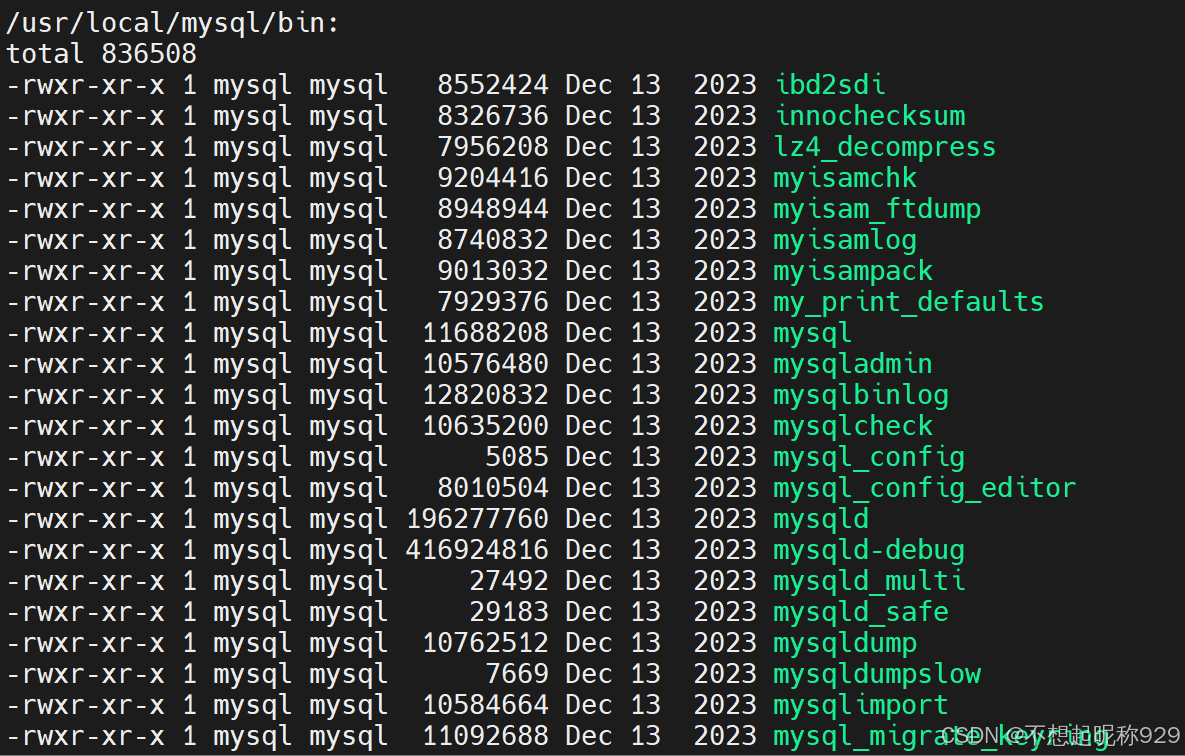二进制方式:
创建组与用户
[root@localhost ~]# groupadd mysql
[root@localhost ~]# useradd -r -g mysql -s /bin/false mysql
解压安装包:
[root@localhost ~]# tar xf mysql-8.0.36-linux-glibc2.28-x86_64.tar.xz -C /usr/local/软连接
[root@localhost ~]# ln -sv mysql-8.0.36-linux-glibc2.28-x86_64 /usr/local/mysql
'/usr/local/mysql' -> 'mysql-8.0.36-linux-glibc2.28-x86_64'初始化
[root@localhost ~]# /usr/local/mysql/bin/mysqld --initialize --user=mysql --datadir=/usr/local/mysql/data
2025-02-04T08:37:33.610736Z 0 [System] [MY-013169] [Server] /usr/local/mysql/bin/mysqld (mysqld 8.0.36) initializing of server in progress as process 2086
2025-02-04T08:37:33.625049Z 1 [System] [MY-013576] [InnoDB] InnoDB initialization has started.
2025-02-04T08:37:34.296122Z 1 [System] [MY-013577] [InnoDB] InnoDB initialization has ended.
2025-02-04T08:37:35.362477Z 6 [Note] [MY-010454] [Server] A temporary password is generated for root@localhost: wYiSf83tCu*2
配置文件
[root@localhost ~]# mkdir /var/log/mysql[root@openEuler-1 ~]# vim /etc/my.cnf
basedir=/usr/local/mysql/
datadir=/usr/local/mysql/data/
socket=/tmp/mysql.sock
log-error=/usr/local/mysql/data/mysqld.log
pid-file=/usr/local/mysql/data/mysqld.pid增加权限
[root@localhost ~]# chown -R mysql.mysql /usr/local/mysql/*
添加系统服务
[root@localhost ~]# cd /usr/local/mysql/
[root@localhost mysql]# ls
bin data docs include lib LICENSE man README share support-files
[root@localhost mysql]# cd support-files/
[root@localhost support-files]# ls
mysqld_multi.server mysql-log-rotate mysql.server
[root@localhost support-files]# vim mysql.server
[root@localhost support-files]# cp mysql.server /etc/init.d/mysqld
[root@localhost support-files]# ll /etc/rc.d/rc3.d/
total 0
[root@localhost support-files]# chkconfig --add mysqld
[root@localhost support-files]# ll /etc/rc.d/rc3.d/
total 0
lrwxrwxrwx 1 root root 16 Feb 4 16:57 S64mysqld -> ../init.d/mysqld
[root@localhost support-files]# chkconfig mysqld on
[root@localhost support-files]# chkconfig --list mysqld
Note: This output shows SysV services only and does not include native
systemd services. SysV configuration data might be overridden by native
systemd configuration.
If you want to list systemd services use 'systemctl list-unit-files'.
To see services enabled on particular target use
'systemctl list-dependencies [target]'.
mysqld 0:off 1:off 2:on 3:on 4:on 5:on 6:off
启动服务
[root@localhost support-files]# systemctl start mysqld
登录MySQL
[root@localhost support-files]# /usr/local/mysql/bin/mysql -uroot -p
Enter password:
Welcome to the MySQL monitor. Commands end with ; or \g.
Your MySQL connection id is 9
Server version: 8.0.36
Copyright (c) 2000, 2024, Oracle and/or its affiliates.
Oracle is a registered trademark of Oracle Corporation and/or its
affiliates. Other names may be trademarks of their respective
owners.
Type 'help;' or '\h' for help. Type '\c' to clear the current input statement.
mysql>修改密码
mysql> alter user root@localhost identified by '123456';
Query OK, 0 rows affected (0.00 sec)配置环境变量
[root@localhost support-files]# vim /etc/profile.d/mysql.sh
export PATH=$PATH:/usr/local/mysql/bin
[root@localhost support-files]# source /etc/profile.d/mysql.sh[root@localhost support-files]# mysql -uroot -p
Enter password:
Welcome to the MySQL monitor. Commands end with ; or \g.
Your MySQL connection id is 10
Server version: 8.0.36 MySQL Community Server - GPL
Copyright (c) 2000, 2024, Oracle and/or its affiliates.
Oracle is a registered trademark of Oracle Corporation and/or its
affiliates. Other names may be trademarks of their respective
owners.
Type 'help;' or '\h' for help. Type '\c' to clear the current input statement.
mysql> 删除系统服务
[root@localhost support-files]# chkconfig mysqld off
[root@localhost support-files]# chkconfig --list mysqld
Note: This output shows SysV services only and does not include native
systemd services. SysV configuration data might be overridden by native
systemd configuration.
If you want to list systemd services use 'systemctl list-unit-files'.
To see services enabled on particular target use
'systemctl list-dependencies [target]'.
mysqld 0:off 1:off 2:off 3:off 4:off 5:off 6:off
删除文件
[root@localhost support-files]# chkconfig --del mysqld
[root@localhost support-files]# ll /etc/init.d/
total 36
-rw-r--r--. 1 root root 18229 Aug 24 2022 functions
-rwxr-xr-x 1 root root 10576 Feb 4 16:55 mysqld
-rw-r--r--. 1 root root 1161 Jun 22 2024 README
[root@localhost support-files]# rm -f /etc/init.d/mysqld第二种方法
配置文件
[root@localhost support-files]# vim /usr/lib/systemd/system/mysqld.serviceDescription=MySQL 8.0 database server
After=syslog.target
After=network.target
[Service]
Type=notify
User=mysql
Group=mysql
ExecStart=/usr/local/mysql/bin/mysqld --basedir=/usr/local/mysql --datadir=/usr/local/mysql/data
ExecStop=/usr/local/mysql/bin/mysqladmin -uroot shutdown
TimeoutSec=300
PrivateTmp=true
Restart=on-failure
RestartPreventExitStatus=1
LimitNOFILE = 10000
[Install]
WantedBy=muli-user.target
加载设置
[root@localhost support-files]# systemctl daemon-reload
